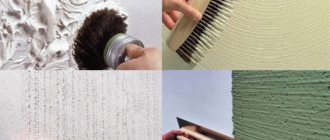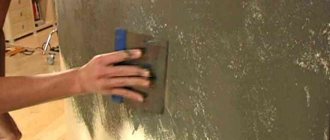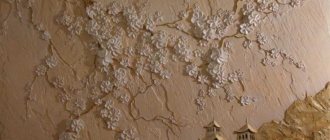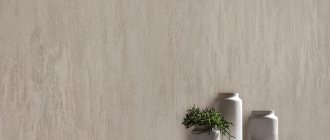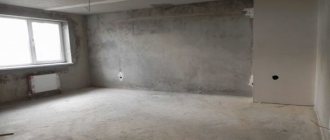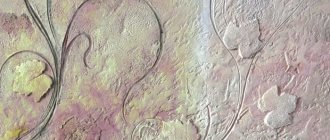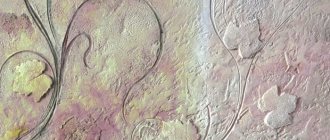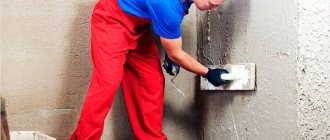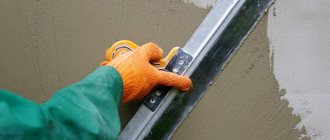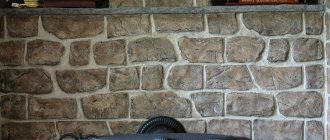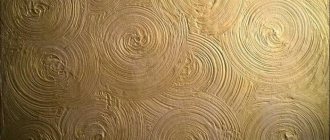A brief excursion into history
Although the origins of imitation marble on walls go back to the times of Ancient Rome, it was during the Renaissance that Venetian architects gave the technique of producing “fake marble” a second wind.
It was since then that the material became known throughout the world under the name “Venetian putty” (plaster).
What is Venetian plaster walls
The main component of the mixture is fine mineral chips (quartz, marble, granite, etc.), which are mixed with slaked lime. To make work more convenient, in recent years, craftsmen have begun to replace lime with synthetic acrylic and add color dyes to obtain the desired color.
Such a replacement does not in any way affect the appearance of the finish, but the mixture dries faster, which can significantly reduce the time of repair work.
Therefore, the question of how to make Venetian plaster, in principle, becomes clear and feasible on your own, because its components are sold in any hardware store.
Application of the Venetian
Classic Venetian plaster can be used in any room. If the application technology is followed, it is perfect for wet areas such as the kitchen or bathroom. Its durability can withstand use for up to 15 years. At the same time, this material does not fade in the sun and retains its properties during “active” use. The only drawback can be considered the complex process of repairing the damaged area. Although it is very difficult to damage a well-laid Venetian. This can only be done with strong mechanical force.
Pros and cons of plaster
The following “strong” qualities speak in favor of choosing this material:
- Long service life, if everything is done correctly (at least 25 years);
- Absence of any joints or seams on the wall surface;
- Withstands mechanical loads, temperature changes, high humidity, which is acceptable in saunas, bathhouses, basements, kitchens or swimming pools;
- Preservation of appearance and original color;
- The presence of a glossy surface effect, which helps to visually enlarge any space;
- It is easy to care for without fear of grouting or damage;
- It is environmentally friendly to humans;
- Hides flaws and surface defects well;
- It can be applied not only to concrete surfaces, but also to drywall or brick;
- Does not crack and protects walls from cracking.
And the lime in its composition will prevent the development of fungal mold.
Among the “disadvantages” are the relatively high price, the need to strictly follow the instructions for applying Venetian plaster, and the complexity of the work.
Important! The product should be prepared for only one day, because... dries quickly and cannot be stored for long periods of time. Even during work, it is recommended to periodically stir the contents of the bucket to maintain the quality of the plaster.
Tools for work
To apply the composition you will need plaster trowels and spatulas. They can be used for applying wax to the surface of plaster, as well as for sanding intermediate layers. Spatulas must be taken in different sizes. The base layer is applied using a large spatula, and the pattern is created with a small or medium spatula. You will also need suede mittens, which will subsequently be used to polish the finished surface. Depending on the scale of the work, an appropriate amount of plaster and color will be needed. The color scheme can be of any color.
Material manufacturing process
The easiest option is to buy a ready-made mixture in a store and dilute it with water to the desired consistency, according to the attached instructions. To do this, it is recommended to use mixers that allow you to obtain a homogeneous creamy mass.
When making the composition on your own, it is important to maintain all the necessary proportions of stone chips, slaked lime and the selected color.
And if the mixture is prepared independently, the order of work will be as follows:
- 1 liter of any water-based acrylic varnish is poured into a 5 liter plastic bucket.
- Then add 100-150 ml of ordinary water.
- After this, add 2.5 kg of dry finishing putty - any polymer or gypsum mixture containing microcalcite, marble flour, or white cement.
- High-quality mixing using a mixer attachment.
- Adding a universal color suitable for decorative plaster or water-dispersed paint (no more than 10% of the total volume of the solution).
The output should be a homogeneous mass, the consistency reminiscent of ordinary putty. From these proportions you will get approximately 3.5 kg of mixture, sufficient to treat about 8 m2 of surface.
Worth knowing! To prolong the “viability” of the mass, it is recommended to add plasticizers for gypsum in small quantities.
Basic application methods
The main difficulties may lie in the process of applying the material to the wall.
In this case, in the classical method it is important to follow the following sequence of work:
- Preliminary cleaning (removal of debris, old wallpaper, dust, residues of building mixtures with sandpaper, etc.) and thorough surface preparation (leveling and priming);
- Applying the 1st layer of “Venetian” using a metal trowel 1-2 mm thick, while making multidirectional movements (you cannot leave residual material on the instrument and allow it to dry in the form of lumps, which subsequently leave scratches, unsightly marks and unevenness);
- After drying, apply a 2nd layer with a thickness of only 0.5-1 mm, which will dry a little less;
- The 3rd layer is applied “to stripping”, similar to the process of finishing putty, called “rubbing”;
- After 30 min. the surface is sanded using fine sandpaper or an abrasive sponge;
- Using a spatula or trowel, polish the wall, holding the tool at an acute angle to the surface, as if smoothing it;
- At the final stage, wax is rubbed in, which after 20 minutes. polished in a circular motion using a soft, dry cloth or a special polishing machine (the wax will add shine and protect well from moisture and possible damage).
Having familiarized yourself with the main stages of the work, it immediately becomes clear how to apply Venetian plaster according to all the rules of the process.
More complex ways are:
- Application in two tones to obtain a specific pattern;
- Creating the effect of natural marble;
- The “sand wind” technique in the form of dunes and other patterns.
In any case, you should first read about the technique itself, watch videos on the desired topic and consult with experts who have already had experience in such work. To begin with, it is recommended to try it on a small section of the wall or on a sheet of drywall.
By carefully following the advice and tips of specialists, it is possible to obtain a truly mesmerizing result, imparting luxury, unusual beauty and sophistication to the environment.
Plastering rules
The peculiarity of the “Venetian” is that it is applied in several layers - from 2 to 10. It all depends on what kind of effect you want to get. The layers are applied in different ways, but they must be leveled and sanded to perfect smoothness. Before applying the next layer, you need to wait until the one already applied dries. Only after all layers have been applied and dried can the surface be coated with wax - beeswax or synthetic.
Important! The use of synthetic wax makes the surface resistant to dampness. Therefore, it is advisable to use this option for the bathroom.
The first layer is applied evenly, according to the same principle as conventional plastering. The base layer can be tinted or not - it all depends on your taste. If you are going to apply the composition in 2-3 layers, the base will show through the colored layers. If the number of layers is more than 5, then the base layer will simply not be visible. It all depends on the quality of the composition.
